Related Research Articles

The Final Solution or the Final Solution to the Jewish Question was a Nazi plan for the genocide of individuals they defined as Jews during World War II. The "Final Solution to the Jewish question" was the official code name for the murder of all Jews within reach, which was not restricted to the European continent. This policy of deliberate and systematic genocide starting across German-occupied Europe was formulated in procedural and geopolitical terms by Nazi leadership in January 1942 at the Wannsee Conference held near Berlin, and culminated in the Holocaust, which saw the murder of 90% of Polish Jews, and two-thirds of the Jewish population of Europe.
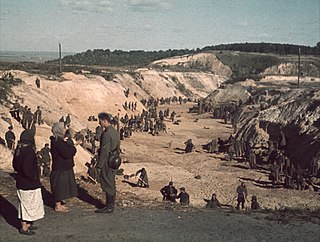
Babi Yar or Babyn Yar is a ravine in the Ukrainian capital Kyiv and a site of massacres carried out by Nazi Germany's forces during its campaign against the Soviet Union in World War II. The first and best documented of the massacres took place on 29–30 September 1941, in which some 33,771 Jews were murdered. Other victims of massacres at the site included Soviet prisoners of war, communists and Romani people. It is estimated that a total of between 100,000 and 150,000 people were murdered at Babi Yar during the German occupation.
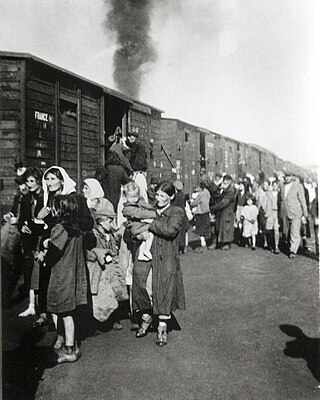
Operation Reinhard or Operation Reinhardt was the codename of the secret German plan in World War II to exterminate Polish Jews in the General Government district of German-occupied Poland. This deadliest phase of the Holocaust was marked by the introduction of extermination camps. The operation proceeded from March 1942 to November 1943; about 1.47 million or more Jews were murdered in just 100 days from late July to early November 1942, a rate which is approximately 83% higher than the commonly suggested figure for the kill rate in the Rwandan genocide. In the time frame of July to October 1942, the overall death toll, including all killings of Jews and not just Operation Reinhard, amounted to two million killed in those four months alone. It was the single fastest rate of genocidal killing in history.

The Holocaust—the murder of about six million Jews by Nazi Germany from 1941 to 1945—is the most-documented genocide in history. Although there is no single document which lists the names of all Jewish victims of Nazi persecution, there is conclusive evidence that about six million Jews were murdered. There is also conclusive evidence that Jews were gassed at Auschwitz-Birkenau, the Operation Reinhard extermination camps, and in gas vans, and that there was a systematic plan by the Nazi leadership to murder them.

Olyka is a rural settlement in Lutsk Raion, Volyn Oblast, western Ukraine. It is located east of Lutsk on the Putylivka Rriver. Its population is 3,032.

Berdychiv is a historic city in Zhytomyr Oblast, northern Ukraine. It serves as the administrative center of Berdychiv Raion within the oblast. It is 44 km (27 mi) south of the administrative center of the oblast, Zhytomyr. Its population is approximately 73,046.
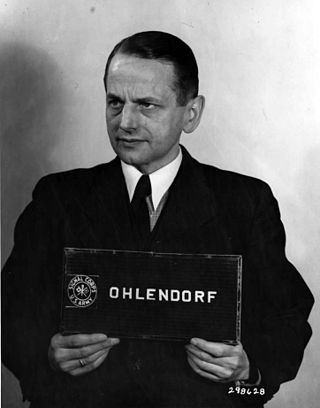
Otto Ohlendorf was a German SS functionary and Holocaust perpetrator during the Nazi era. An economist by education, he was head of the Sicherheitsdienst (SD) Inland, responsible for intelligence and security within Germany. In 1941, Ohlendorf was appointed the commander of Einsatzgruppe D, which perpetrated mass murder in Moldova, south Ukraine, the Crimea and, during 1942, the North Caucasus. He was tried at the Einsatzgruppen Trial, sentenced to death, and executed by hanging in 1951.

Husiatyn is a rural settlement in Chortkiv Raion, Ternopil Oblast, western Ukraine. It hosts the administration of Husiatyn settlement hromada, one of the hromadas of Ukraine. Husiatyn is located on the west bank of the Zbruch River, which once formed the old boundary between Austria-Hungary and the Russian Empire in the 19th century, and the boundary between Poland and the Soviet Union during the 1920s and 1930s. The population is 7,032.

Busk is a city located in Zolochiv Raion in Lviv Oblast (region) of western Ukraine. It hosts the administration of Busk urban hromada, one of the hromadas of Ukraine. Population: 8,662.
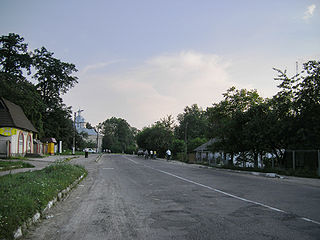
Medenychi is a rural settlement in Drohobych Raion (district) of Lviv Oblast (region) in Western Ukraine. It hosts the administration of Medenychi settlement hromada, one of the hromadas of Ukraine. Population: 3,292 . Local government is administered by Medenychi Settlement Council.

The Kamianets-Podilskyi massacre was a World War II mass shooting of Jews carried out in the opening stages of Operation Barbarossa, by the German Police Battalion 320 along with Friedrich Jeckeln's Einsatzgruppen, Hungarian soldiers, and the Ukrainian Auxiliary Police. The killings were conducted on August 27 and August 28, 1941, in the Soviet city of Kamianets-Podilskyi, occupied by German troops in the previous month on July 11, 1941. According to the Nazi German reports a total of 23,600 Jews were murdered, including 16,000 who had earlier been expelled from Hungary.

Patrick Desbois is a French Roman Catholic priest, former head of the Commission for Relations with Judaism of the French Bishops' Conference and consultant to the Vatican. He is the founder of the Yahad-In Unum, an organization dedicated to locating the sites of mass graves of Jewish victims of the Nazi mobile-killing units in the former Soviet Union. He received the Légion d'honneur, France's highest honor and the Order of Merit of the Federal Republic of Germany, Germany's highest honor for his work with Yahad-In Unum documenting the Holocaust in Eastern Europe.
The Holocaust in Belarus refers to the systematic extermination of Jews living in the Byelorussian Soviet Socialist Republic during its occupation by Nazi Germany in World War II. It is estimated that roughly 800,000 Belarusian Jews were murdered during the Holocaust. However, other estimates place the number of Jews killed between 500,000 and 550,000.

The Holocaust in Ukraine was the systematic mass murder of Jews in the Reichskommissariat Ukraine, the General Government, the Crimean General Government and some areas which were located to the East of Reichskommissariat Ukraine, in the Transnistria Governorate and Bessarabia, Northern Bukovina and the Hertsa region and Carpathian Ruthenia during World War II. The listed areas are currently parts of Ukraine.
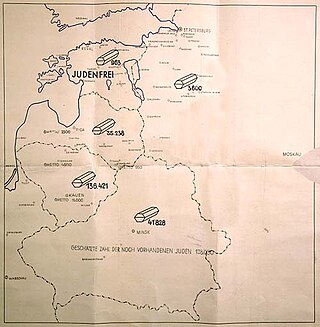
The Holocaust in Russia is the Nazi crimes during the occupation of Russia by Nazi Germany.

The Lemberg Mosaic, subtitled the "Memoirs of Two who Survived the Destruction of Jewish Galicia", is a book on The Holocaust by Jakob Weiss. This work brings to light the relatively obscure history of the systematic and total destruction of Jewish Lemberg. It is presented in the format of a biography, detailing the struggle for survival of four families in the backdrop of two back-to-back invasions of the city and surrounding region by both the Soviets (1939) and the Germans (1941).

Bronna Góra is the name of a secluded area in present-day Belarus where mass killings of Polish Jews were carried out by Nazi Germany during World War II. The location was part of the eastern half of occupied Poland, which had been invaded by the Soviet Union in 1939 in agreement with Germany, and two years later captured by the Wehrmacht in Operation Barbarossa. It is estimated that from May 1942 until November of that year, during the most deadly phase of the Holocaust in Poland, some 50,000 Jews were murdered at Bronna Góra forest in death pits. The victims were transported there in Holocaust trains from Nazi ghettos, including from the Brześć Ghetto and the Pińsk Ghetto, and from the ghettos in the surrounding area, as well as from Reichskommissariat Ostland.

The Tarnopol Ghetto was a Jewish World War II ghetto established in 1941 by the Schutzstaffel (SS) in the prewar Polish city of Tarnopol.
The Museum of the Holocaust - Museo del Holocausto in Guatemala city is the first museum of the Holocaust in Central America.

The Holocaust by Bullets is a memoir and investigation written by Father Patrick Desbois, a French priest who uncovered the truth behind the murder of 1.5 million Jews in the occupied Soviet Union by Nazi and Nazi aligned forces. Published in 2008, the book details Desbois’ journey in locating and studying the Holocaust in Eastern Europe. In the early chapters, Desbois describes his grandfather's story of incarceration, an experience that drove him to study the Holocaust. The book features some of the hundreds of testimonies of witnesses or requisitioned villagers who were present at mass executions that Desbois has collected with the help of translators, historians, and archival scholars. This memoir brings to light the emotional impacts of genocide and the intimate, human dimensions of the Nazi extermination.
References
- ↑ "A Priest Bears Witness - Moment Magazine". Momentmag.com. 7 February 2012. Retrieved 5 October 2015.
- ↑ "Father Patrick Desbois". Yahad in Unum. Retrieved 26 August 2024.
- ↑ "Holocaust by Bullets". Catholic.co.il. Retrieved 5 October 2015.
- ↑ "Honorary Doctorates Awarded During Bar-Ilan University's 54th Annual Board of Trustees Meetings". .biu.ac.il. 12 May 2009. Retrieved 5 October 2015.
- ↑ "US Supreme Court Justice Sonia Sotomayor to Speak at NYU's 2012 Commencement". Nyu.edu. 22 March 2012. Retrieved 5 October 2015.
- ↑ "Yahad-In Unum". holocaustremembrance.com. Retrieved 26 August 2024.
- ↑ "2019 Yakir Keren Hayesod Award recipient". Keren Hayesod. Retrieved 26 August 2024.
- ↑ "Yahd in Unum, board". Yahad in Unum. Retrieved 26 August 2024.
- ↑ "David Black". Schneps Media. 26 August 2024. Retrieved 26 August 2024.
- ↑ Stella Schossberger (1990). Yitzhak Arad; Shmuel Krakowski; Shmuel Spector (eds.). The Einsatzgruppen Reports: Selections from the dispatches of the Nazi Death Squads' campaign against the Jews: July 1941–January 1943. United States Holocaust Museum. ISBN 978-0896040571.
- ↑ Crowe, David (2008). The Holocaust: Roots, History, and Aftermath. Boulder, Colorado: Westview Press. ISBN 978-0813343259.
- 1 2 3 "Yahad in Unum, About us" . Retrieved 26 August 2024.
- ↑ "NJBA Winners". Jewishbookcouncil.org. Retrieved 5 October 2015.
- 1 2 "The map of the Holocaust by bullets". Yahad-In Unum. Retrieved 26 August 2024.
- ↑ YIU website Archived July 2, 2012, at the Wayback Machine
- ↑ "Проєкт розслідування воєнних злочинів Росії: збір доказів" (in Ukrainian). Retrieved 2023-09-05.
- ↑ "The Russian War Crime Project, gathering evidence" . Retrieved 2024-08-26.